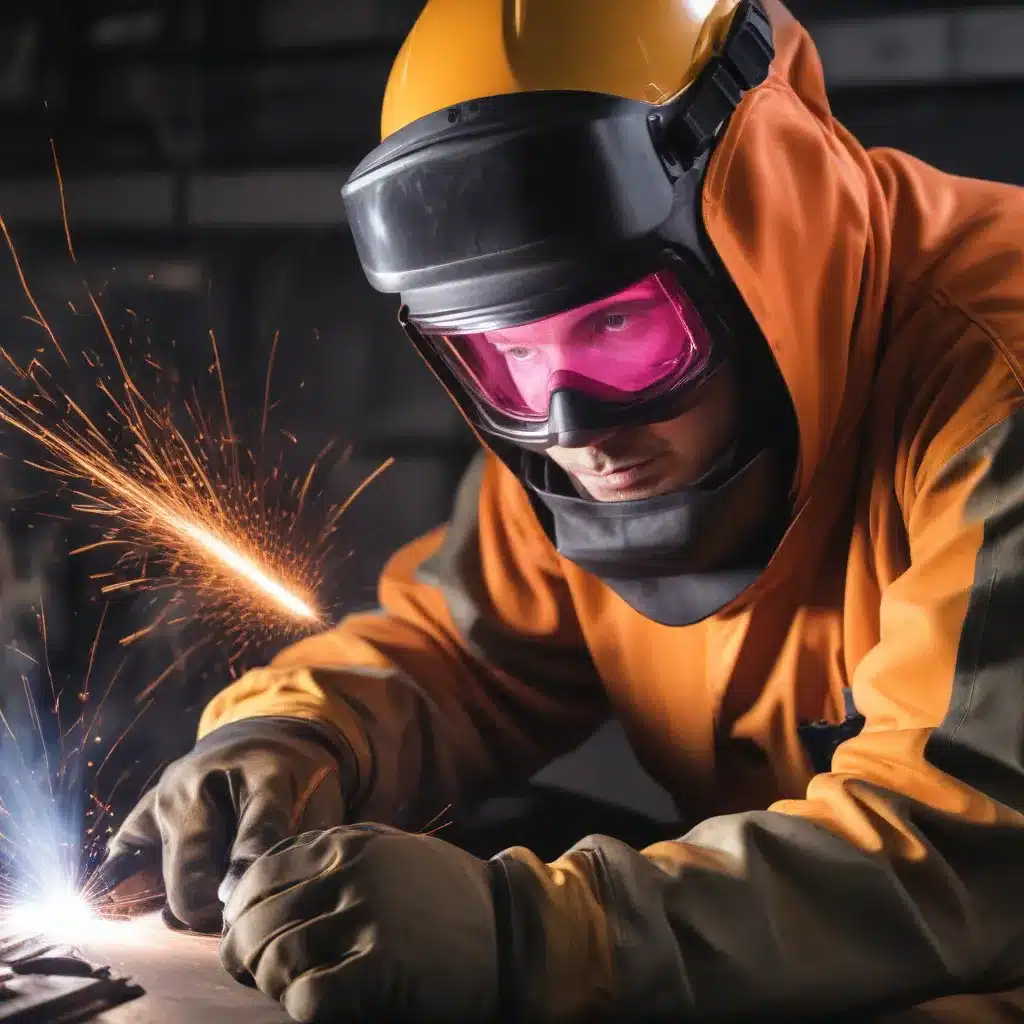
As an experienced welder and metal fabricator, I’ve spent countless hours honing my craft and perfecting the art of transforming raw materials into functional, durable masterpieces. But behind the sparks and the sizzling metal, there’s a crucial aspect of our work that often goes unnoticed: the importance of eye protection.
The Dangers of Welding: Understanding the Risks
Welding is a demanding profession, and the risks to our eyes are ever-present. The intense light and radiant energy emitted during the welding process can wreak havoc on our sensitive peepers if we’re not vigilant about using the proper protective gear. From the searing UV rays to the blinding arc flash, the hazards are numerous and can have serious long-term consequences.
One of the most common eye injuries we face is photokeratitis, often referred to as “welder’s flash.” This painful condition occurs when the cornea becomes inflamed due to overexposure to ultraviolet light. Imagine having your eyes feel like they’re on fire – that’s the reality for many welders who don’t take the necessary precautions.
But the dangers don’t stop there. We also face the threat of cataracts, a clouding of the eye’s lens that can gradually rob us of our sight. And let’s not forget about the risk of retinal burns, which can lead to permanent vision damage. These are not theoretical risks; they’re very real threats that we face every time we strike an arc.
The Importance of Proper Welding Gear
Knowing the dangers, it’s clear that equipping ourselves with the right protective gear is not just a good idea – it’s an absolute necessity. And at the heart of this safety equation lies the humble welding helmet.
These helmets are our first line of defense against the perils of our trade, and they come in a variety of shapes, sizes, and styles. But what really sets them apart is the all-important filter lens, which is where the magic happens.
Navigating the Welding Shade Spectrum
Welding shades are numerically rated based on their ability to filter light, and the appropriate shade number is determined by the type of welding process, the material being welded, and the welding current. The Occupational Safety and Health Administration (OSHA) and the American National Standards Institute (ANSI) have established guidelines to ensure we’re using the correct shade for the job.
For example, when performing gas welding or brazing, the OSHA-mandated minimum shade is number 4, while the ANSI-recommended shade is 5. But when it comes to arc welding, the required minimum can range from shade 10 for light welding to shade 14 for the most intense processes.
Now, I know what you’re thinking: “Shade 14? That’s practically welding in the dark!” But trust me, getting the right balance between visibility and protection is crucial. Too low a shade, and you risk searing your retinas; too high, and you might as well be trying to thread a needle while wearing a blindfold.
The Evolution of Welding Helmets: Embracing Innovation
Thankfully, the world of welding gear hasn’t stood still. Manufacturers have been hard at work, pushing the boundaries of what’s possible and delivering innovative solutions to safeguard our eyes.
One of the game-changers in the industry is the advent of auto-darkening welding helmets. These marvels of engineering automatically adjust the filter lens, transitioning from a lighter shade to a darker one the instant the arc is struck. Gone are the days of fumbling with a manual darkening knob, risking a split-second of unprotected exposure.
But the innovation doesn’t stop there. Some of the latest welding helmets feature advanced optical coatings that provide superior UV and infrared protection, ensuring our eyes are shielded from the full spectrum of harmful radiation. And the ergonomic design of these helmets? It’s like they were custom-tailored for our heads, offering a comfortable, secure fit that doesn’t compromise our mobility or visibility.
Battling the Elements: Specialized Welding PPE
As if the dangers of the welding arc weren’t enough, we also have to contend with the harsh environmental conditions in which we ply our trade. Whether it’s the scorching heat of the steel mill or the bone-chilling cold of the cryogenic lab, our eyes need specialized protection to withstand these extreme conditions.
That’s where the latest personal protective equipment (PPE) comes into play. Manufacturers have developed heat-reflective coatings and cryogenic-resistant materials to shield our eyes from the elements, ensuring we can work safely and comfortably in even the most challenging environments.
Fostering a Culture of Safety: The Welder’s Responsibility
While the technological advancements in welding gear are undoubtedly impressive, the true responsibility for eye safety ultimately rests with us, the welders. It’s our duty to stay informed about the latest industry standards, to prioritize the use of proper protective equipment, and to set an example for our colleagues.
After all, our eyes are the windows to the world, and we can’t afford to take them for granted. By embracing the innovative solutions available and cultivating a culture of safety in the workplace, we can ensure that the sparks keep flying, the metal keeps shaping, and our vision remains clear, now and for years to come.
So, the next time you strike an arc, take a moment to appreciate the ingenious tools at your disposal. With the right welding helmet and the proper protective gear, you can weld with confidence, knowing that your eyes are guarded against the hazards of our trade. And who knows, maybe you’ll even inspire your fellow welders to do the same, one helmet at a time.
As I step back from the workbench, wiping the sweat from my brow and admiring the gleaming metal before me, I can’t help but feel a sense of pride in our profession. Welding is a craft that demands skill, precision, and an unwavering commitment to safety. And with the continued advancements in welding gear and the shared responsibility to protect our eyes, I know that the future of our industry is brighter than ever.


